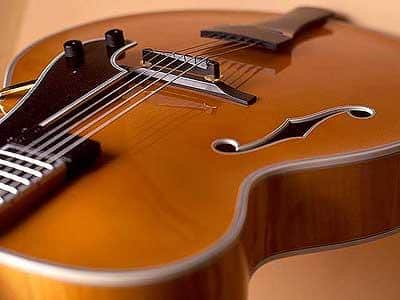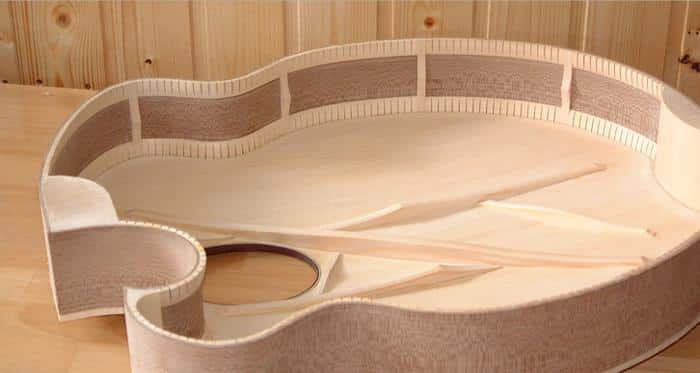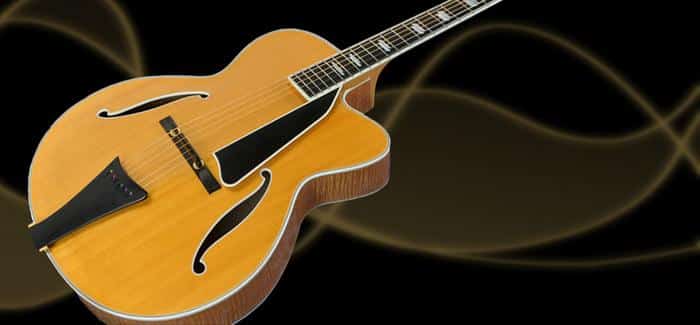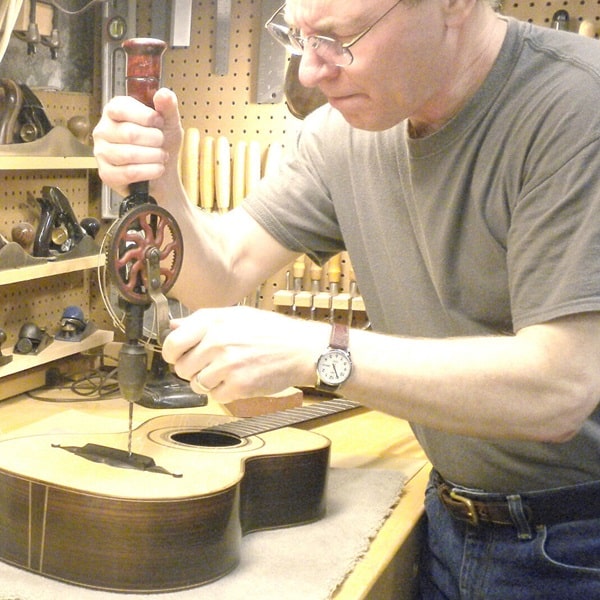Introduction to the Archtop Guitar
Picture this—the year is 1902, and a skilled luthier named Orville Gibson has just crafted a musical innovation that would shape the world of music forever. It was a guitar model unlike any other, rich in both beauty and sound resonance—a little something we fondly refer today as the archtop guitar. When struck, the strings vibrate in a way that creates a sound as unique and as peculiar as the instrument’s form—a sound that has echoed through the ages, from then until now. But let’s leave the rest of this transformative tale for a later moment in our discussion.
On this journey, we’ll dip our feet into a pool of discovery, exploring the endless ocean that is the world of electric and acoustic archtop guitars. I’ve spent a significant portion of my life as a luthier, uncovering the secrets and complexities that lie within each unique archtop model. My experience births a deep understanding of the distinctive qualities and edge that these instruments have been imbued with.
Intricate in their design, with a sound that amounts to a delightful paradox of warm yet sharp tones—the archtop guitar is an enigma waiting to be unfurled. Through my years, I’ve delved into their construction, analyzed their influence throughout music history, and admired the notable models that have stood the test of time. So, journey with me, as we embark together into the rich tapestry of the archtop guitar, its historical significance, intricate construction, and lasting influence.
It’s time to open your mind to a world of music you thought you knew—only to find out, there’s so much more to learn.
Historical Overview and Evolution
Influence on Jazz Music

As we explore the historical overview and evolution of arch top guitars, we cannot overlook their profound influence on jazz music. Jazz, with its intricate chord progressions and improvisational melodies, required an instrument capable of matching its ambitious reach. The arch top guitar was that instrument.
In the palms of jazz guitars maestros, the conversation between the arch top guitar’s distinct acoustic characteristics and the innovative leanings of jazz resulted in a dynamic musical evolution. The pure, vibrant tone of archtops, with their ability to handle amplified sound, packed a punch in tight jazz ensembles while also offering the versatility needed for solo work. From Dixieland to bebop, each subgenre of jazz found a unique voice in the arch top guitar.
Bob Benedetto, a master luthier and a name revered in the jazz community, revolutionized jazz guitar design. His handcrafted archtop guitars have become synonymous with jazz excellence. I have been fortunate enough to witness first-hand his craft, which marries top-quality materials with meticulous construction to create a perfect fit for the demanding acoustic profile of jazz music.
Through my own experiences in crafting instruments for jazz musicians, I can affirm that the arch top guitar’s contribution to jazz is as significant as the genre’s influence on the instrument’s development. It forms a sort of symbiotic relationship, where one inspires the other to greater heights. The arch top guitar, with its evolving designs and acoustic enchantment, has indeed played a pivotal role in shaping jazz music’s rich history and will undoubtedly continue to influence its future
Aligning with the harmonic sophistication of jazz, it is fascinating to see how the construction of the arch top guitar allows it to sing in this complex genre. Next, we’ll explore this intriguing construction process that marks another milestone in the evolution of these exceptional instruments.
Construction of Archtop Guitars
Comparison of Body Materials

The integrity of an archtop guitar and the fields of sound it can create largely hinge on the combination of materials utilised in its construction. In this light, the significance of body materials becomes clear, weaving into the overall narrative of archtop guitar construction.
Foremost in the construction of archtop guitars we find two body materials consistently put to use: maple and steel. A maple guitar body lays claim to popularity in many genres including jazz, lending to this wood’s balance of sonic qualities such as brightness, tonal warmth and rich sustain. Maple’s sturdy structure paired with its visual charms—such as the alluring patterns of its grain—make it a choice material in the guitar crafting realm.
On the other hand, steel string instruments, with their sharp tonality and potent resonance, deliver a much different musical experience. Building an archtop with a steel string friendly composition involves using dense, rigid materials that can withstand the tension. The choice between these materials often comes down to the guitar player’s personal preferences and unique playing style.
My expertise in different materials used in guitar construction gives me an advantageous perspective. Understanding the subtle differences and interactions between these materials allows me to see how they contribute to the overall sound and playing experience of the instrument.
In essence, the differences in body materials are paramount in creating the very soul of a guitar. From the selection of wood or metal to the treatment processes involved in preparing these materials for construction, each decision becomes a crucial step in manifesting the instrument’s potential. As we comprehend these nuances, we gain an enriched understanding of the uniqueness of archtop guitars.
By no means is this a comprehensive list of all possible body materials for archtop guitars, rather a focus on the commonly encountered maple and steel. Hopefully, this investigation into the all-important body materials underscores their role in the story of the archtop guitar, demonstrating their contribution to the overall sound and the player’s experience. The careful choice of body materials, subtle as it may seem, greatly enhances the versatility and expressiveness of these instruments, illuminifying the intent and expertise of their craftsmen.
As our journey shifts from construction to a more detailed analysis of the differences between archtops and other types of guitars, keep in mind the vital role these materials play in the guitar’s construction and overall narrative.
Differences Between Archtop and Other Guitars

Having worked with a variety of guitar types, I can draw clear comparisons and contrasts between archtop guitars and other designs, highlighting their unique features that might influence your choice of instrument. It’s important to understand that the framework and foundational characteristics of these guitars play a significant role in their tone, functionality, and appeal.
All guitars are not created equal. What unique characteristics put the archtop in a league of its own? Indeed, one of the most striking physical distinctions lies in the archtop’s f-holes, as opposed to the traditional round sound hole seen in most other guitars. These f-holes not only give the archtop its distinct, sophisticated aesthetic, but also impact its tonal qualities. The archtop’s construction allows it to produce a bright, clear tone with a strong projection, characteristics favored by jazz and blues musicians worldwide.
Apart from its distinctive sound, the archtop’s unique architecture sets it apart. Designed with a carved top and back that rise in a gentle arch, it looks and operates markedly different from flat top guitars. This arched design contributes significantly to the vibrational patterns of the guitar, which in turn dictate the characteristics of the sound that it produces. In comparison, other guitar designs, like the flat top, take a simpler approach with a sound box designed to resonate with the strings, amplifying their vibration.
Beauty, tone, and playability converging in one masterful design is what makes the archtop an object d’art. Its body that beautifully arches, the decisively carved f-holes, and not to forget its machined precision – all of these factors culminate in an instrument that’s as much a piece of visual art as it is an extraordinary source of sound.
In terms of playability, archtop guitars have a slightly more challenging learning curve due to their larger bodies and heavier gauge strings. However, with practice, many guitarists find the unique tone worth the extra effort. Traditional flat top guitars, on the other hand, are typically lauded for their ease of use and versatility, making them a more common choice for beginners.
Yet, despite the differences, the archtop, with its rich history and unique construction, shares essential attributes with other guitars. They are, after all, tools for making music, with a common goal of producing a pleasing sound. Each design, whether an archtop or another, has its strengths and weaknesses, and serves its purpose well within its domain.
We will continue this exploration in the coming sections, diving deeper into the construction of archtop guitars, the influence on jazz music and the benefits of choosing an archtop guitar. From notable models to frequently asked questions, this comprehensive guide aims to enrich your understanding of this beautiful instrument.
Notable Modern and Historical Models

In journeying through the history and development of archtop guitars, one can’t overlook the tremendous contributions made by significant manufacturers and their standout models. As a luthier with over two decades of experience, I’ve had the privilege of working with a wide-ranging collection of guitars. The depth of craftsmanship and design ingenuity I’ve seen in these instruments truly astounds me, making me appreciate the art of luthiery even more.
The Gibson ES undoubtedly sits high on my list of remarkable archtop guitars. Introduced back in the 1930s, the ES series quickly gained popularity amongst musicians. Known for the warmth, clarity and balance of their sound, these guitars have served as reliable partners for a multitude of genres, from jazz to rock and blues. With their elegant design, these archtops are not only outstanding in sound production but also in aesthetics.
A later entrant to the scene, but certainly not lesser in stature, are the models from Eastman guitars. Built with precision and attention to detail, Eastman guitars have come to be synonymous with affordability without any compromise on quality. Eastman has managed to bring together traditional hand-crafting techniques with modern design elements to create splendid instruments, at a fraction of the cost of their historical counterparts.
The hook that pulls us from the vintage charm of Gibson ES guitars to the contemporary appeal of Eastman models is the enduring beauty of archtop design. From the legendary Gibson ES to modern Eastman guitars, what makes these archtop models stand out? It’s the unique combination of visual allure, sonic depth, and unwavering durability, manifesting in different ways across diverse models.
Another notable name in our discussion is Collings Guitars. The meticulous craftsmanship imparted into each Collings archtop makes these guitars highly sought after. While second to none in terms of aesthetics, the tone and playability of Collings guitars speak volumes about the guitar makers’ dedication to maintaining the highest standards. Modern takes on classic designs deliver remarkable resonance and sustain, making these works of art as enticing to play as they are to behold.
Exploring these remarkable models has been an enriching journey for me, challenging me to strive for excellence in my own work as a luthier. Whether it’s traditional models like the Gibson ES that carry a rich history or more recent additions like Eastman and Collings guitars that reinterpret classic blueprints for modern needs, watching the legacy of archtop guitars evolve has been intensely rewarding.
These instruments embody not just the fundamentals of a great archtop, but also the ability to push beyond those parameters, exploring new frontiers in design, materials, and construction techniques. They each represent a unique chapter in the story of archtop guitars, a story that is far from finished. As the world of music continues to change, so too do the tools we use to create it. The archtop guitar stands as a testament to this evolution, and as a luthier, I can say with certainty that its journey is as exciting as the music it produces.
Benefits of Archtop Guitars

Coming from my many years of experience crafting various types of guitars, and being an avid player myself, there’s something truly special about archtops. As we journey further into exploring the archtop guitar benefits, it is important to comprehend the considered nuances that increase its appeal across diverse musical genres.
What makes the archtop a favorite with jazz and blues musicians? Here’s where we delve into the unique benefits only an archtop guitar can offer. The connection to Jazz is timeless: the time-honored silhouette, the sweet, warm tones have become synonymous with modern jazz guitars. The archtop’s clarity cuts through the mix of a big band, its projection being just right, whilst the complexity of overtones doesn’t oversaturate or muffle the sound. If you close your eyes and imagine a smoky Chicago jazz club during its golden era in the early 20th century, it’s the rich, bittersweet tone of the archtop guitar that rings through.
But it’s not just the distinctive sound that compels musicians. An archtop’s aesthetic is inimitable. There’s a luthier’s artistry in every carved curve, a soulful craftsmanship in the intricately worked f-holes and the bespoke tailpieces. They’re objects of tangible beauty, evoking a nostalgia and charm that’s quite irresistible. The sultry curves of these guitars aren’t just for looks either. They contribute to its unmatched acoustic properties: a rounded, well-defined treble that blends seamlessly into a warm, resonant bass.
The archtop’s sound projection capabilities make it highly suitable for ensemble performances. It can switch between rhythm and lead roles with ease, demonstrating its versatility. Adversely, playing the archtop as a solo instrument unveils a different side to its persona: a profound depth and broad dynamic range that brings out the voice of the musician within, enabling them to truly make the instrument their own. Its responsiveness to touch, whether plucked lightly or strummed hard, imbues an intimate connection between the guitar and its player.
Indeed, the list of benefits can be extensive. Yet, the appeal of the archtop, comes from many elements which harmoniously unite in this outstanding instrument. As a luthier creating these beautiful pieces and a guitarist playing them, the depth of the archtop’s allure remains boundless. From its aesthetics to its tonal quality, its rich history, to its integral role in jazz, there’s no questioning that the archtop guitar holds a special place in the heart of musicians and collectors alike. It just proves to be an instrument exceptionally suited to express the musician’s own voice.
The archtop guitar is an enchanting confluence of musical instrument, artistic beauty, and historical artifact – a symbiosis best experienced first-hand. Its charm is timeless, its echo is unforgettable. As we continue exploring our journey with the archtop, its unique voice, and the corners of music history it has touched, the archtop guitar proves to be a stalwart representative of tradition and innovation in harmony.
FAQs
What is an archtop guitar?
What distinguishes archtop guitars from other types?
What genres of music are archtop guitars commonly used in?
How to choose a good quality archtop guitar?
Conclusion
So now that we’re familiar with archtop guitars, are they the unsung heroes of the guitar world? My extensive knowledge and passion tell me, in terms of craft, tone, and influence, they indeed are. We’ve journeyed from their rich historical evolution, understanding their essential contribution from the age of jazz and beyond.
Through a detailed analysis, we’ve compared their construction to other guitar types, looked at established and noteworthy models, and appreciated the remarkable benefits of these instruments. With their distinct sound produced by their unique construction and body materials, archtop guitars have carved out a unique space in the guitar world.
Their powerful resonance and versatility attest to their unrivalled value. Drawing from my journey and understanding, I see the unsung eminence of these instruments. For the informed guitarist, the archtop may not be just another guitar; it could become a beloved instrument, a personal narrative in music.
As we part, remember, the beauty of music lies within its diversity, and the archtop guitar beautifully contributes to this vibrant spectrum. Not only have we learned about the archtop but also deepened our appreciation for this artful world of stringed instruments.

R.M. Mottola, an engineer-turned-luthier, revolutionizes stringed instrument design with his deep focus on acoustics and ergonomics since 1994. As editor of the Savart Journal and a key contributor to American Lutherie, Mottola merges science with artistry in lutherie. He enriches the field with his extensive knowledge, shared through his Liutaio Mottola website, making him a beacon in the world of modern instrument craftsmanship.
